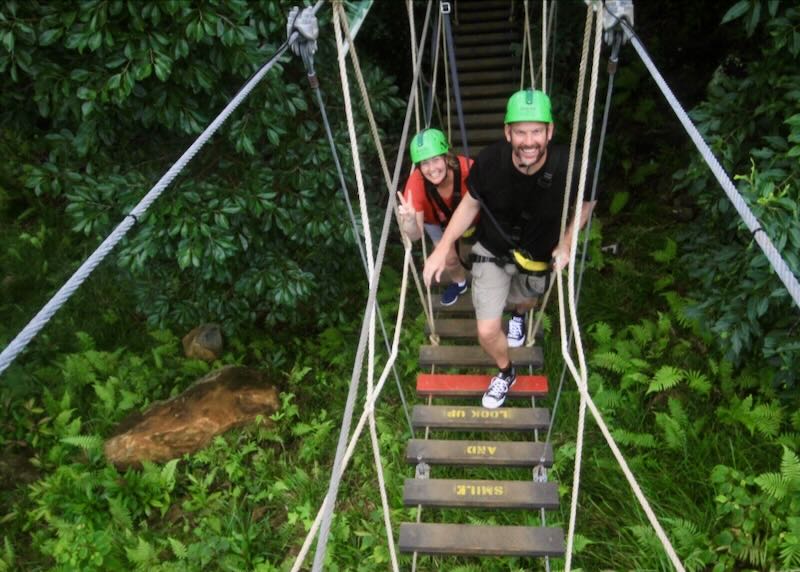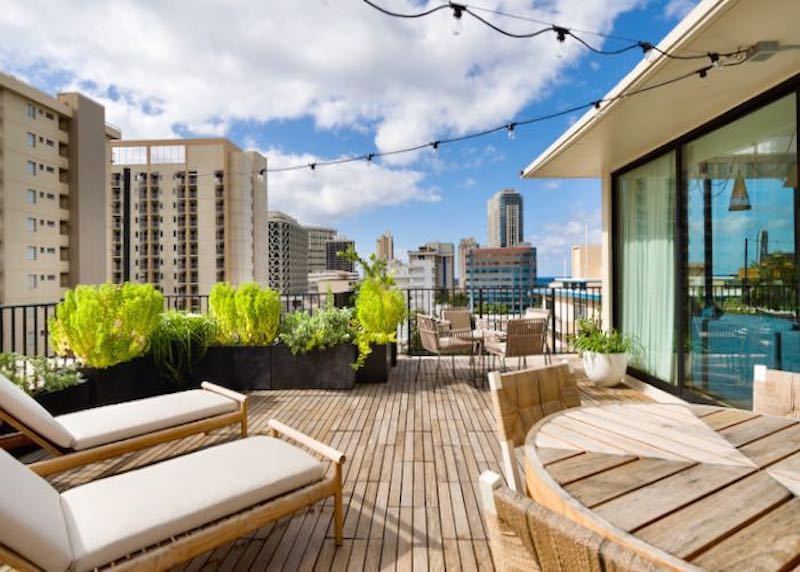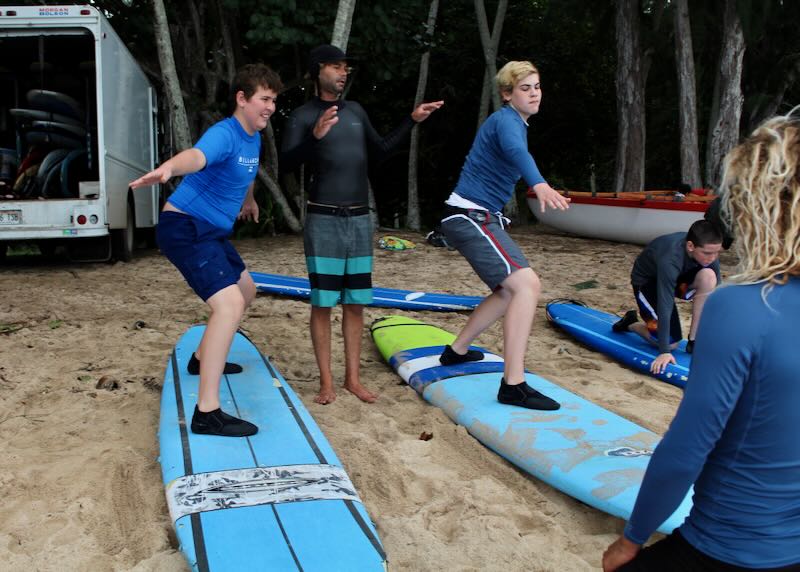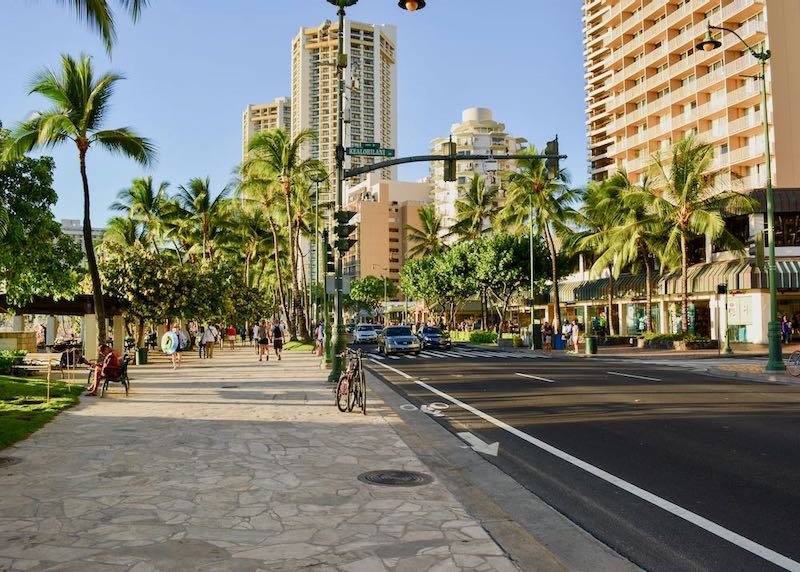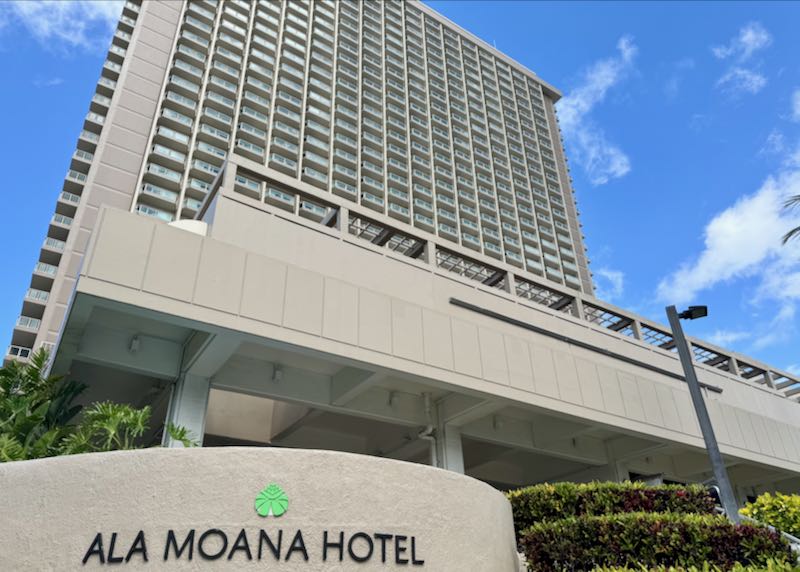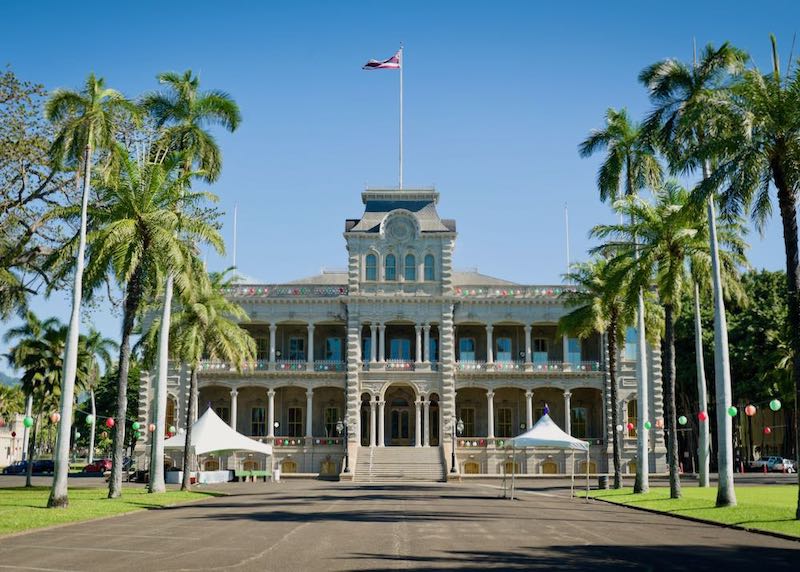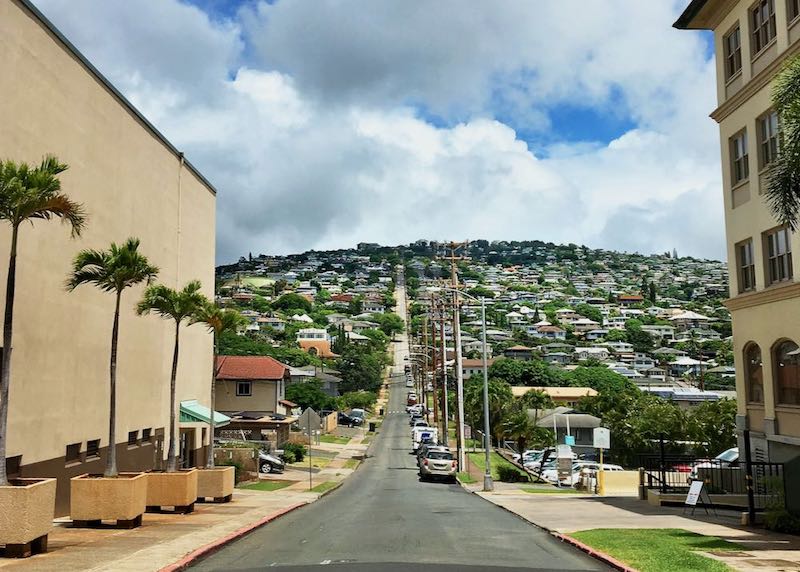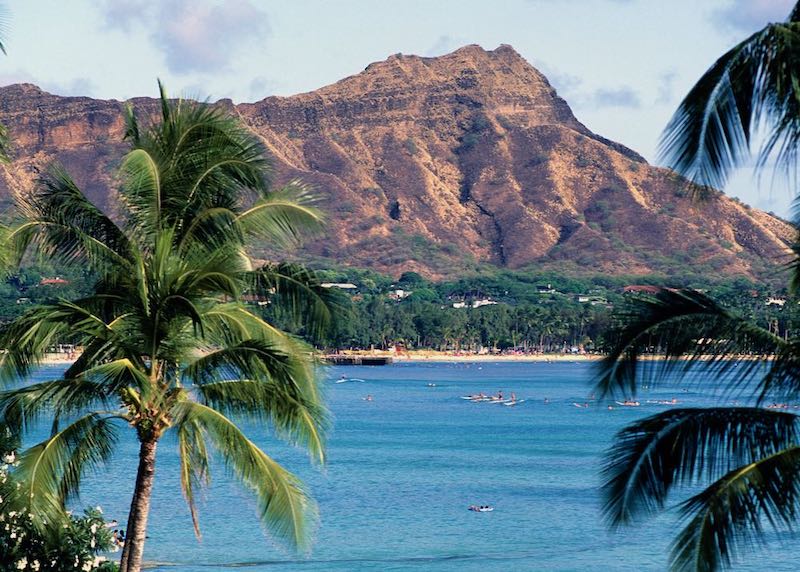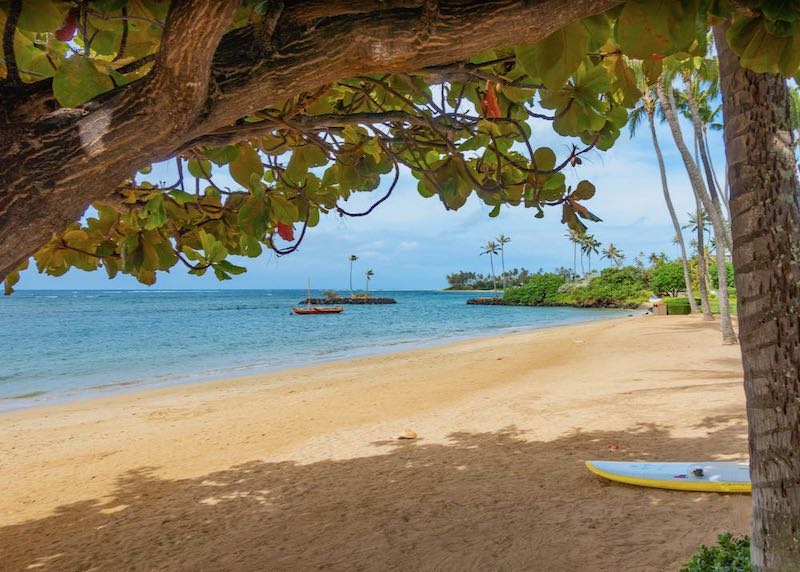By Seattle Dave
My Favorite Hotels in Honolulu
• 5-Star: Halekulani
• 4-Star: The Modern
• 3-Star: Coconut
• Cheap: VIVE
• For Couples: Surfjack
• For Families: Moana Surfrider
• Suite with Kitchen: Ilikai
• Best Pool: Halekulani
• Best Beach: Hilton Hawaiian Village
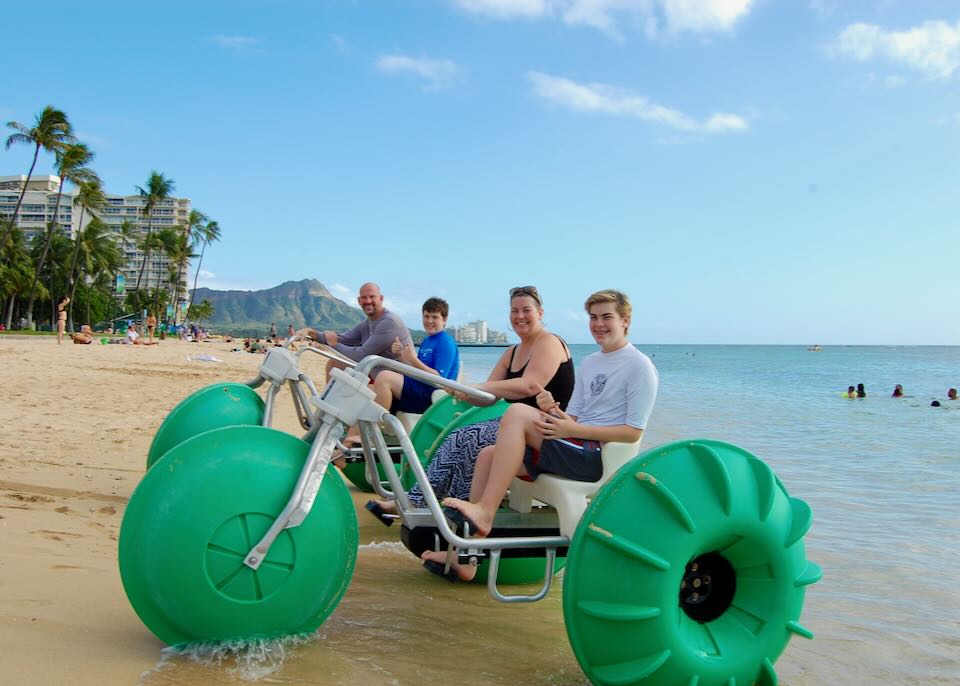
My wife, two boys, and I having fun on Waikiki beach in Honolulu.
The Best Areas to Stay in Honolulu
Honolulu, the most remote large city in the world, is a must-visit for anyone traveling to Oahu for the first time. It’s a bustling tropical beach city that stretches for about 12 miles along the southern coast of Oahu, from the international airport to Makapu’u Point.
The city boasts an intriguing mix of modern hotels, trendy restaurants, and vibrant nightclubs. It also offers a wealth of history, art, and natural wonders, including the iconic Diamond Head volcanic cone.
Honolulu’s history traces back to habitation signs from the 11th century. However, it was only established after King Kamehameha I took over Oahu. In 1845, it was declared the capital of the Kingdom of Hawaii by Kamehameha III. Despite facing several upheavals over the years, Honolulu has emerged as a premier travel destination since Hawaii gained statehood in 1959.
My wife and I on a zipline tour near Honolulu.
While Honolulu is Hawaii’s largest city, most tourist attractions are concentrated around Waikiki. Nearly 35% of households in Honolulu don’t own cars, thanks to the city’s excellent bus service and bike lanes. The bus system connects all neighborhoods within the city, as well as destinations across the island, including Pearl Harbor, Hale’iwa, and Ko Olina. The fare for a one-way bus ticket is $2.75, while a full-day pass costs $5.50. Children aged 5 and under travel for free.
Honolulu consists of several distinctive neighborhoods that travelers will enjoy. Waikiki is known for its iconic beaches, high-rise hotels, and vibrant dining and nightlife. Ala Moana offers a beautiful beach park and abundant shopping opportunities, while Downtown features an arts district, heritage buildings, and upscale dining. Kaimuki and Kapahulu offer a local vibe and fantastic restaurants. Diamond Head is famous for its volcano hiking trails, peaceful beaches, and proximity to Honolulu Zoo. Kahala, a luxury residential neighborhood, is known for its pristine beaches and celebrity sightings.
The Best Places to Stay in Honolulu
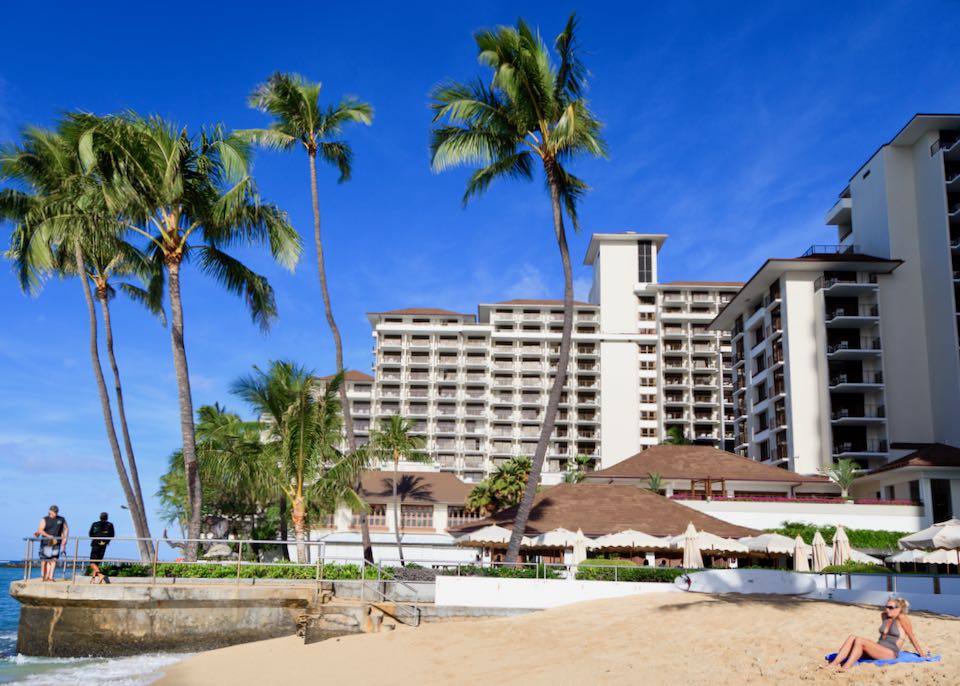
The Halekulani has a marvelous spot on Waikiki Beach and is the best luxury hotel in Honolulu.
- Best Luxury Hotels in Honolulu
Halekulani • Moana Surfrider • The Modern Honolulu- Best Honolulu Hotels for Families
Moana Surfrider • Coconut Waikiki Hotel • Ilikai Hotel & Luxury Suites • Hyatt Regency Waikiki Beach Resort & Spa- Best Boutique Hotels in Honolulu
Surfjack Hotel & Swim Club • Lotus Hotel • Hotel Renew- Best Cheap/Midrange Hotels in Honolulu
The Equus • VIVE Hotel Waikiki- Top TripAdvisor Hotels (Best Value)
Prince Waikiki • Hotel La Croix • Halekulani • VIVE Hotel WaikikiBest Areas in Honolulu for…
The Surfjack Hotel & Swim Club is the best boutique hotel in Honolulu.
- Best Beaches in Honolulu: Waikiki, Ala Moana, Diamond Head, Kahala
The best neighborhoods for beach vacations are Waikiki, Ala Moana, Diamond Head, and Kahala. Waikiki offers the busiest beaches with the most services, dining, surfboard rentals and lessons, and water sports centers. Ala Moana is the best area for young swimmers and snorkelers with a fun beach park and an almost waveless, shallow lagoon on Magic Island. Diamond Head features excellent swimming, surfing, and snorkeling near family-friendly attractions, including a zoo, aquarium, and beach park. Kahala offers the most serene beaches, ideal for sunbathing and relaxing, though some are a little rocky.- Best Places for Sightseeing in Honolulu: Downtown, Waikiki, Diamond Head
Downtown is the best place for exploring the historic landmarks of Honolulu, boasting America’s only royal palace, the city’s iconic lighthouse, art galleries, cultural museums, and performance venues. Densely populated Waikiki is home to fewer historic sights than Downtown, but offers public artworks depicting Hawaiian life and local heroes along the main thoroughfare Kalakaua Avenue, along with a handful of museums, including the Lucoral Museum (ocean geology, including coral and pearls, with jewelry-making workshops) and the Hawaii Army Museum Society (weapons, tanks, a helicopter and more, mostly from WWII and the Korean and Vietnam Wars – free admission). Diamond Head offers the most family-oriented attractions, including the zoo, aquarium, and Kapi’olani Beach Park.My kids doing surf lessons in Oahu.
- Best Places for Families in Honolulu: Waikiki, Diamond Head, Ala Moana
Waikiki offers the best lodging options for families, with thousands of hotel rooms and suites to choose from, many with kids clubs and activities, most with wonderful pools and family-friendly restaurants on-site, and all either beachfront or under three blocks away from the ocean. Just south of Waikiki, Diamond Head is home to the Honolulu Zoo, Waikiki Aquarium, Kapiolani Park, and its namesake Diamond Head State Monument with its popular hiking trail up to the summit of a dormant volcano – perfectly doable for older kids, though young children and toddlers may need to be carried for parts of the hike. Ala Moana is another excellent choice for its wonderful beach, shallow lagoon, great snorkeling (often with sea turtles), plus its record-holding open-air mall and numerous dining options.- Most Romantic Places in Honolulu: Waikiki, Diamond Head, Kahala
Waikiki offers the most options for a romantic night on the town, with exciting restaurants, atmospheric cocktail bars, all-night dancing, and plenty of hotels catering to couples with special perks like sunset view lanais, outdoor jacuzzis, or private pools. Kahala is a wonderful spot for a honeymoon or romantic getaway with beachfront fine dining, stylish bars, and serene, secluded beaches in the shadow of Diamond Head volcano. The Diamond Head neighborhood is best known for its volcano with a flower-filled hiking trail with dreamy, panoramic views over the city, rainforest, and ocean. Diamond Head also boasts quieter beaches, fun local attractions, and convenient access to Waikiki’s nightlife.
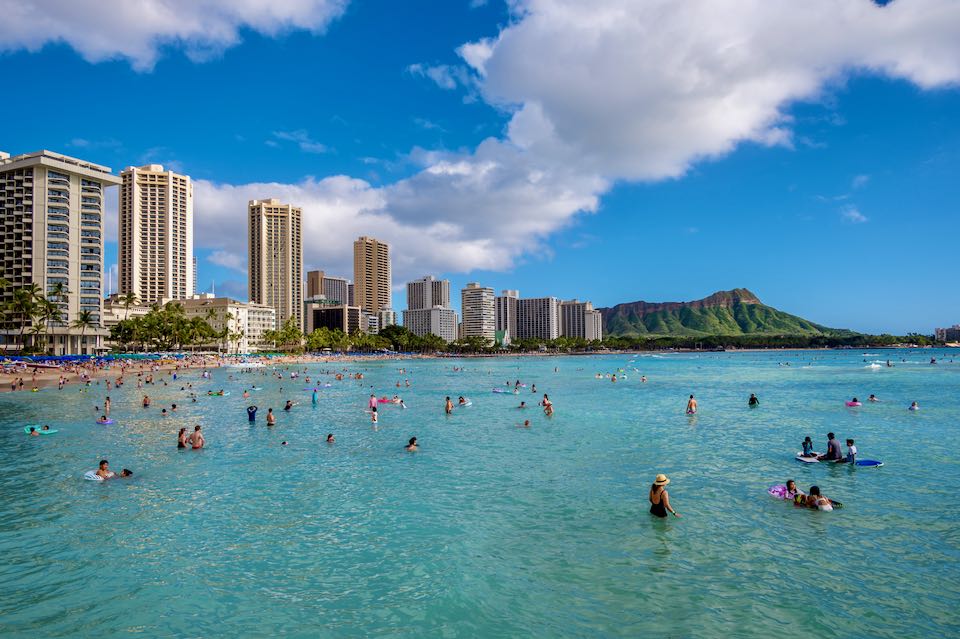
The Moana Surfrider (first hotel on left) on Waikiki Beach in Honolulu.
- Best Places for Shopping in Honolulu: Ala Moana, Kaimuki, Kapahulu
For luxury and name-brand clothing, accessories, home goods, and souvenirs, Ala Moana is the best area. Its enormous mall, Ala Moana Center, features over 350 stores and restaurants alone, plus nearby Ward Village mall adds another 170 shops and restaurants. The area is also served by several local food markets, a farmers’ market on Thursdays, and has easy access to a second farmers market in the nearby Kaka’ako neighborhood on Saturdays. For vintage, thrift, and locally made goods, check out the Kaimuki and Kapahulu areas; their main streets are lined with small boutiques selling everything from vintage surfboards and aloha shirts to hand-made candy and jewelry to used ukeleles and specialty stores stocking omiyage, stationery, fabrics, antiques, and more.- Best Places for Food and Nightlife in Honolulu: Waikiki, Ala Moana, Kaimuki, Kapahulu, Downtown
The Kaimuki and Kapahulu areas are home to generations-old local diners, new farm-to-table restaurants, and an eclectic range of cuisines. Downtown offers a plethora of fine dining restaurants and craft cocktail bars. Waikiki and Ala Moana are home to most of Honolulu’s bars and nightclubs. Last call in Honolulu is 2:00 a.m., but a few clubs in Waikiki operate under a cabaret license, allowing them to serve alcohol until 4:00 a.m.
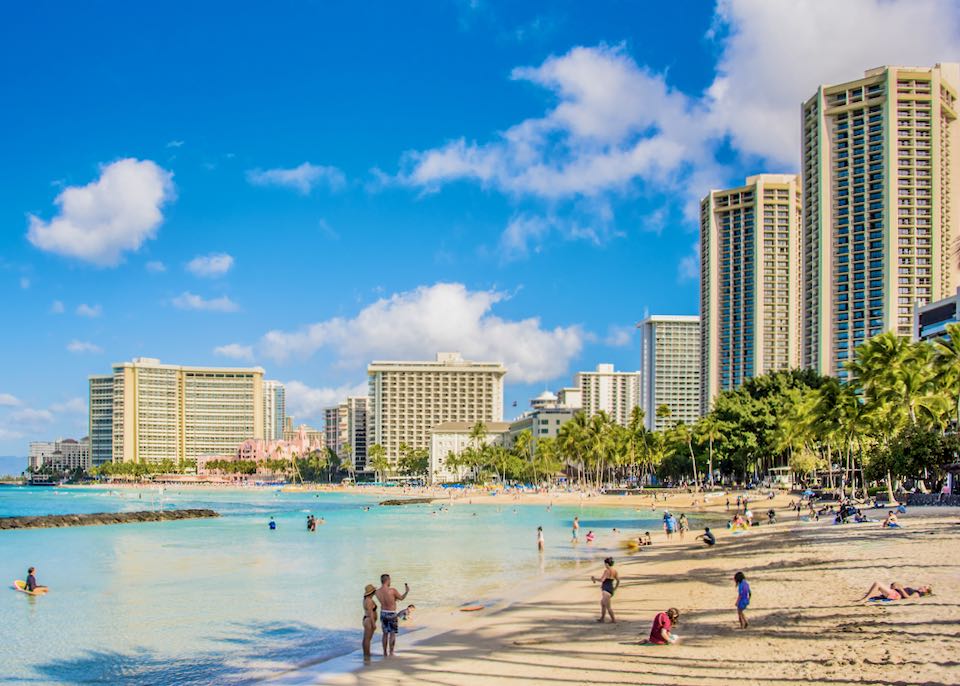
Beautiful Waikiki Beach in Honolulu. Beachfront hotels from closest to farthest: Moana Surfrider • Royal Hawaiian • Sheraton Waikiki • Halepuna Waikiki • Halekulani. The Hilton Hawaiian Village is just visible at the very end of the beach.
- Best Places for a Local Vibe in Honolulu: Kaimuki, Kapahulu
The best areas for living local style are Kaimuki and Kapahulu, both older neighborhoods with no tourism infrastructure. Down-home restaurants serve plate lunch and poke, trendy new restaurants spotlight local, sustainable fare, boutiques offer Hawaiiana made with quality over kitsch, and specialty stores focus on the tastes and needs of residents. There are no hotels here; just a couple of vacation homes and condos for rent.- Safest Areas of Honolulu
Compared to similar-sized American cities, Honolulu has an average crime rate overall. Most crimes in Honolulu are property crimes, especially burglarizing rental cars and purse snatching. Violent crime is much less common. The safest neighborhoods in the city are at the southeast end near Diamond Head, Kahala, and Kaimuki.- Unsafe Areas of Honolulu
Honolulu is a safe city overall, but crime does happen. As in most travel hotspots, crime in Honolulu is most common around tourist hotspots like Waikiki and the historic Downtown area, so be cautious with your valuables in these areas. Tourists in Honolulu are easy to spot and often carry cash and expensive phones and cameras, so as in any major city, don’t leave valuables in your car, do be aware of your surroundings, and after dark, stick to busy, well-lit streets.The Best Places in Honolulu for Tourists
See Also
1. Waikiki
A former resort for Hawaiian royalty in the 1800s, Waikiki is Hawaii’s first travel destination. Two-thirds of all Hawaiian hotels are on the island of Oahu, and the vast majority of those hotels are in Waikiki. But it’s far from a tourist trap. The Waikiki neighborhood is also the most densely populated area with Honolulu residents with high-rise condos and apartments sharing streets with a wide range of hotels. Once firmly connected to the rest of Honolulu, Waikiki is almost an island now, surrounded on three sides by the ocean and the manmade Ala Wai Canal.
Of course, Waikiki is best known for its beaches. Once a continuous stretch of white sand, urban development has now carved out five discrete beaches here. From northwest to southeast, they are: Kahanamoku, Fort DeRussy, Gray’s (AKA Halekulani), Waikiki Beach (AKA Royal Hawaiian), and Kuhio Beach. All beaches in Waikiki have soft sand (replenished from other Hawaiian beaches over decades) and gentle to moderate waves buffered by a reef, though there are a few rocky patches mostly near the southeast end. Waikiki is the birthplace of modern surfing, ushered in by Duke Kahanamoku who adapted the ancient Hawaiian sport in the early 1900s. The beaches here are ideal for a variety of water sports, including surfing, paddleboarding, snorkeling, traditional outrigger canoeing, and more. Aside from world-class beaches, Waikiki features a lagoon (ideal for beginning swimmers), the Waikiki Aquarium, a free 10-minute fireworks show every Friday night (set off from Hilton Hawaiian Village), gourmet and casual dining (with especially good Japanese food), and high end shopping along Kalakaua and Kuhio Avenues.
- Best Hotels: Halekulani • Moana Surfrider • Outrigger Waikiki Beach • Surfjack Hotel & Swim Club • Coconut Waikiki Hotel • The Modern Honolulu • Hotel Renew • Shoreline Hotel Waikiki • Hilton Hawaiian Village
2. Ala Moana
North of Waikiki across the Ala Wai Canal is the Ala Moana neighborhood, known for shopping and white-sand beaches. In ancient Hawaii, the area was home to fishermen and taro fields. The area was designated as a retail district in 1949 and is now known for its luxury shops, fashion boutiques, and mainstream retailers. Ala Wai Center is the largest open-air shopping center in the world with over 350 shops and restaurants spread over 4 floors. Nearby ‘Iolani Center is a family-owned boutique established in 1953 offering Hawaiian-inspired clothing and accessories made on site. Locally-sourced produce, flowers, and food can be found at the Foodland Farms, South Shore Market, Honolulu Farmers Market (Wednesdays 4:00 p.m. to 7:00 p.m.), and nearby Kaka’ako Farmers Market (Saturdays 8:00 a.m. to 12:00 p.m.) Trendy restaurants here serve a range of Hawaiian, Japanese, fusion, and international cuisines; bars and restaurants are plentiful here, too. Spanning the coastline is the 100-acre Ala Moana Regional Park with a long white sand beach fronting the main park, plus Magic Island (pictured above) jutting out into the ocean with a kid-friendly lagoon filled with colorful fish on its own tiny beach. Surf tends to be gentle here, tamed by a coral reef just offshore.
- Best Hotel: Ala Moana Hotel
3. Downtown
Downtown Honolulu is the city’s historic and government center. This area includes the smaller neighborhoods of Chinatown, the Arts District, and part of Kaka’ako, the warehouse district at the western border of Ala Moana. A popular sightseeing area, Downtown is home to Honolulu’s oldest buildings: the Mission Houses (from 1821), Washington Place (1847, former home of Queen Lili’uokalani), the Cathedral of St. Andrew (1867), Ali’iolani Hale (1872) ‘Iolani Palace (1879, pictured above, the only royal residence in America), Hawaii Theatre (1822), and the ten-story Aloha Tower lighthouse (1926). Merchant Street offers a dense collection of mid-19th century buildings in a hodgepodge of architectural styles, while the Arts District collects numerous art galleries, history museums, community centers, and concert halls. North of the Arts District is historic Chinatown; revived in recent years, this area now hosts a range of restaurants, open-air markets, and upscale boutiques selling handmade jewelry, designer aloha shirts, vintage clothing, and locally crafted accessories, apparel, and home goods. Tons of excellent restaurants Downtown include a range of Asian cuisines (from Chinese to Filipino, Japanese to Thai, Korean, Lao, Vietnamese, and everything in between), creative and traditional Hawaiian foods, plus New American fine dining, crowd-pleasing Italian, and more. You’ll find no shortage of craft beer halls, sophisticated cocktail lounges, live music venues, and hole-in-the-wall bars here. The closest beach is at Ala Moana, about a half-hour walk or 15-minute bus ride away.
- Best Hotel: Aston at the Executive Centre Hotel
4. Kaimuki and Kapahulu
Kaimuki and Kapahulu are adjoining neighborhoods east of Waikiki and north of Diamond Head. Kapahulu sits to the west of Kaimuki with 5th and 6th Avenues forming a rough border between them. Together these areas make up the best spot in Honolulu for living like a local (or at least eating like a local). There are no high-rise hotels or condos here. Instead, you’ll find smaller apartment complexes and single-family homes, mostly built from the 1940s on according to the owners’ preferences, creating an eclectic mishmash of buildings in Art Deco, Mission, Tudor, and more styles. Decades-old diners and mom-and-pop specialty shops share space with contemporary boutiques and chic restaurants along the main streets of each neighborhood (Waialae Avenue in Kaimuki and Kapahulu Avenue in Kapahulu). Highlights of Kaimuki include the Crack Seed Store (dried fruit candy for over 70 years), Town (farm-to-table dining), Okata Bento (delicious, filling, and crazy cheap), Kaimuki Superette (locally-sourced breakfast, brunch, and lunch), and the KCC Farmers Market (local produce, cheap eats, and flowers – Saturdays from 7:30 a.m. to 11:00 a.m.) Kapahulu’s best include Haili’s Hawaiian Foods (local comfort foods since 1950), Leonard’s Bakery (famous malasadas), Ono Seafood (amazing poke), King’s Pizza Cafe (best pizza in Honolulu), Waiola Shave Ice (super thin-shaved; order it with ice cream on the bottom and a “snow cap:” condensed milk on top). The closest beaches are Queen’s and Kaimana (AKA Sans Souci), about a half-hour walk or a 20 to 30-minute bus ride away, depending on your starting point.
5. Diamond Head
The Diamond Head neighborhood lies south of Waikiki, Kapahulu, and Kaimuki and west of Kahala. The neighborhood takes its name from the Diamond Head volcanic tuff cone there, called Le’ahi in Hawaiian. Hiking up the lush trails to take in panoramic views over the island and ocean from the summit of the volcano is among the most popular things to do in Honolulu. At the southern base of the volcano, there are a couple of small, quiet beaches at Le’ahi and Makalei Beach Parks, popular for surfing and sunsets. West of the volcano, there are a handful of family-friendly attractions, including the Honolulu Zoo, Queen Kapiʻolani Regional Park, and the Waikiki Aquarium. Two excellent beaches are on the western coast, Kapi’olani and Kaimana (AKA Sans Souci) Beaches – both livelier than those south of Diamond Head but calmer than those farther north in Waikiki. There are a few upscale beachfront restaurants with sunset views at Kaimana Beach, but most restaurants are in neighboring Kapahulu and Waikiki.
- Best Hotels: Lotus Honolulu Hotel • Kaimana Beach Hotel
6. Kahala
Often called the “Beverly Hills of Hawaii,” Kahala is the most affluent neighborhood of Honolulu. Due east of Diamond Head and Kaimuki, real estate in Kahala is the most expensive in the state (non-beachfront homes average $3 million; tear-downs run about $1.5 million), with a large chunk of properties used as vacation homes by uber-wealthy tycoons and celebrities. This relaxed neighborhood is home to a string of secluded beaches, a little windy at times but with mostly gentle waves, calmed down by the area’s location in a bay and behind a reef. A broad selection of restaurants, cafes, and shops can be found in the Kahala Mall, while high-end restaurants are located in and around the area’s only hotel, the luxurious Kahala Hotel & Resort. The hotel also boasts a dolphinarium with feeding, swimming, and petting experiences available. At the west end of the neighborhood near Diamond Head is the Shangri La Museum of Islamic Art, Culture, and Design, located in the former estate of socialite Doris Duke.
- Best Hotel: The Kahala Hotel & Resort
